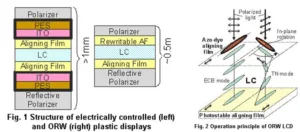Technology – A new Optical Rewritable Liquid Crystal Display (ORWLCD) technology is under development by a team in the Center for Display Research at Hong Kong University of Science and Technology.
ORWLCD is based on a bistable effect and thus does not need any power to sustain a static image once the image has been optically written. One implementation of the technology allows the presentation of passive glasses-based stereoscopic 3D imagery.
The most recent technical paper written by the team is entitled “Optically rewritable 3D liquid crystal displays”. It was published in Optics Letters, Vol. 39, Issue 21, pp. 6209-6212 (2014). A copy of this article is available for purchase online and can be found here.
Unlike a conventional LCD, the ORWLCD uses a polarizer material for the substrates and does not include electrodes. The alignment direction of the liquid crystal on the lower substrate is fixed. The alignment direction of the liquid crystal on the top of the liquid crystal layer is adjustable. It is induced by an azo-dye aligning material and is determined by the axis of polarization and the angle of incidence of the light used to write the image. The image is written by varying the alignment direction of selected regions in the top layer of liquid crystal. Rotating the alignment of the top layer causes the bulk of the liquid crystal layer to adopt either an ECB (parallel) or a TN (twisted) configuration. The different configurations and hence the image can be written, visualized and rewritten through a polarizer.
In practice, the display imagery is changed utilizing a writing unit that consists of an LCD mask and a 450nm LED exposure source.
In as much as the liquid crystal structure is always stabilized by the surface, the image itself is highly stable. It can be written to a desired grey level and rewritten a large number of times with highly reproducible properties.
Since the new display does not require either separate substrates or electrodes, the resulting display is thinner and requires less energy than a conventional, electrically addressed LCD.
The technology claims to offer a variety of other advantages:
- Display and drivers are separated.
- The display is cheap, simple and well suited for mass production.
- Image properties, such as shade of grey, are not sensitive to the cell gap. (50% gap change tolerable.)
- High contrast in reflective mode (>81:1 with >30% reflection).
The technology is represented as having potential for applications that include displays for plastic cards such as phone cards or credit cards, supermarket labels and for blue laser printable paper-like matter.
The team has also disclosed a concept for a stereoscopic 3D ORWLCD. This is accomplished by dividing the image into three zones: one for the left eye in which the light is twisted 45 degrees to the left, a second for the right eye in which it is twisted 45 degrees to the right and a third for the background and front of the image in which it is unmodified. A quarter-wave plate is placed on the top of the ORWLCD and is the means for establishing the differing states of polarization of light emerging from the three zones. Polarized glasses worn by the viewer thus make the image appear three-dimensional by providing a different view to each eye.
Given a good “light printer,” the complete 3D image can be updated on the ORWLCD display in a single step. A video illustrating this effect can be found at the end of this article.
The current prototype ORWLCD can only display grayscale images and does not have a refresh rate fast enough to display video. However, the team believes that, with further development, color can be added and refresh rates increased enough to allow for video playback. – Arthur Berman
Hong Kong University of Science and Technology, Vladimir G. Chigrinov, [email protected]

